From basic functions like unconsciously breathing to more complex ones like making a delicious carbonara for dinner, the nervous system plays a significant role in helping you accomplish all daily functions!
Being the organ system involved in our autonomic functions, motor control, sensation and much more, it’s no wonder why this system is so important and without a doubt, a high yield topic on the MCAT!
In this guide, we’ll give you all a concise and basic understanding of the nervous system and all its important components and divisions. Let’s get started!
Nervous System on the MCAT: What You Need to Know
Topics on the nervous system will be tested on the biology section of the MCAT and can appear both as passage based and fundamental discrete questions.
Compared to other topics where you can’t give a certain breakdown or probability of questions showing up, we can say with confidence that you’re likely to encounter a good amount of questions covering the nervous system: give or take 6-9 questions on average.
Introductory biology accounts for 65% of the content covered in the Biological and Biochemical Foundations of Living Systems section (Bio/Biochem), 5% of content tested in the Chemical and Physical Foundations of Biological Systems (Chem/Phys), and 5% of material on the Psychological, Social, and Biological Foundations of Behavior (Psych/Soc).
Important Sub-Topics: Nervous System
Because the components and concepts of the nervous system can be a little more complicated (don’t be “nervous”!), it might be helpful to maybe draw visuals to aid in your understanding!
We’ll always include visuals to help with your guys’ grasp of the topic, but sometimes even drawing them out yourselves may help in internalizing the information better!
1. Major Functions and Divisions of the Nervous System
Though the nervous system has many functions, it primarily acts as the body’s control system. This allows for the processing of external and internal sensory stimuli and the enaction of motor function as response often to maintain homeostasis.
The first main divisions of the nervous system are the central nervous system (CNS), which includes the brain and spinal cord, and the peripheral nervous system (PNS), comprising all the nerves outside the CNS.
The PNS is further divided into the somatic division, which involves conscious, voluntary action, and the autonomic division, which involves unconscious, involuntary function like heart rate!
The autonomic nervous system is further divided into the sympathetic branch, which executes your “fight or flight” response in times of stress, and the parasympathetic branch, which enacts your “rest and digest” response when distress is not present!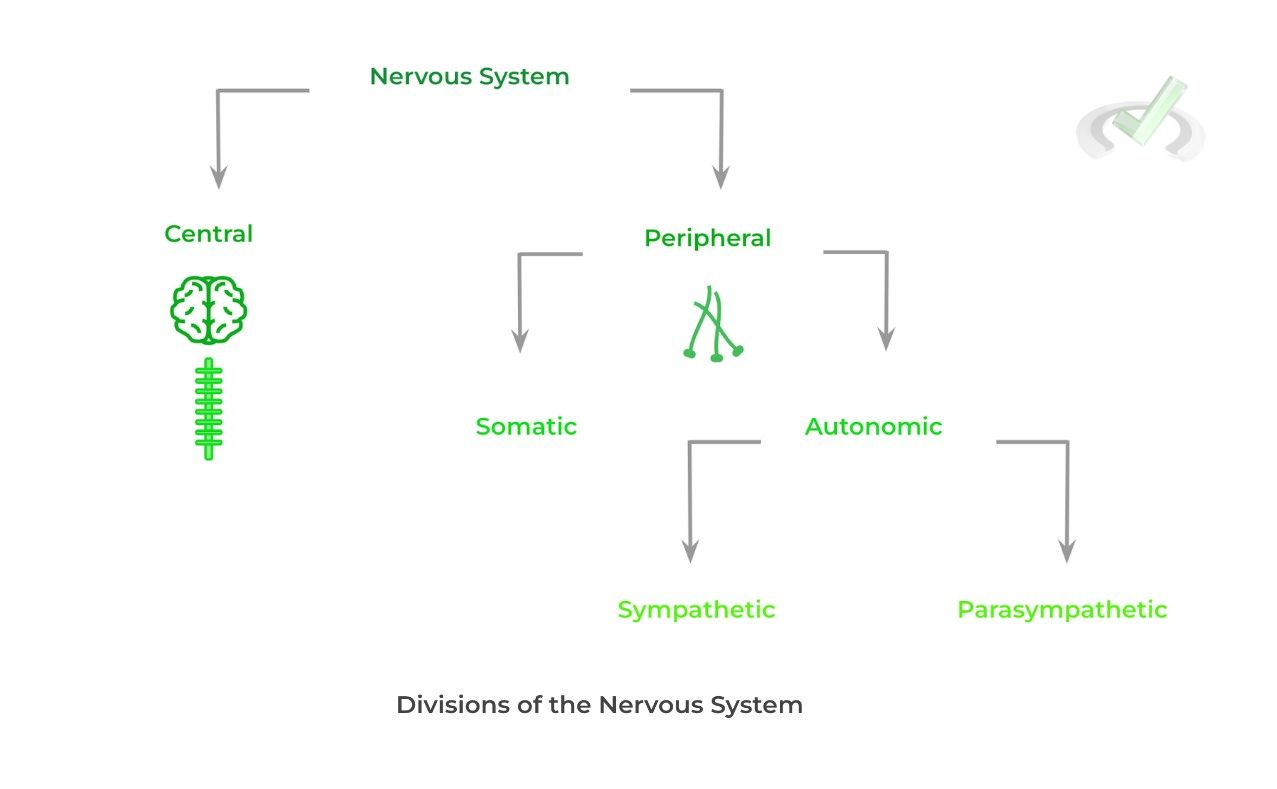
Sensory and motor information travel within the divisions of the nervous system via afferent (sensory) and efferent (motor) neurons, respectively.
Sensory stimuli travel from the PNS to the CNS to be processed by the brain via afferent neurons and motor response signals travel in the opposite direction via efferent neurons.
(Coming Soon!) Full Study Notes : Major Functions and Structural Organization of Nervous System
For more in-depth content review on the structure and function of the nervous system, check out these detailed lesson notes created by top MCAT scorers.
2. Cells of the Nervous System
The main cells of the nervous system are neurons, which allows for intracellular transmission of sensory and motor information via electrochemical impulses! There are 3 main components of neurons: the soma, axon, and dendrites.
The soma (cell body) is the portion of the neuron involved in basic cellular functions as seen in other cells. The axon allows for the propagation of information via an action potential as we’ll discuss later. Dendrites extend from the neuron and receive the informative signals from the action potential of another neuron.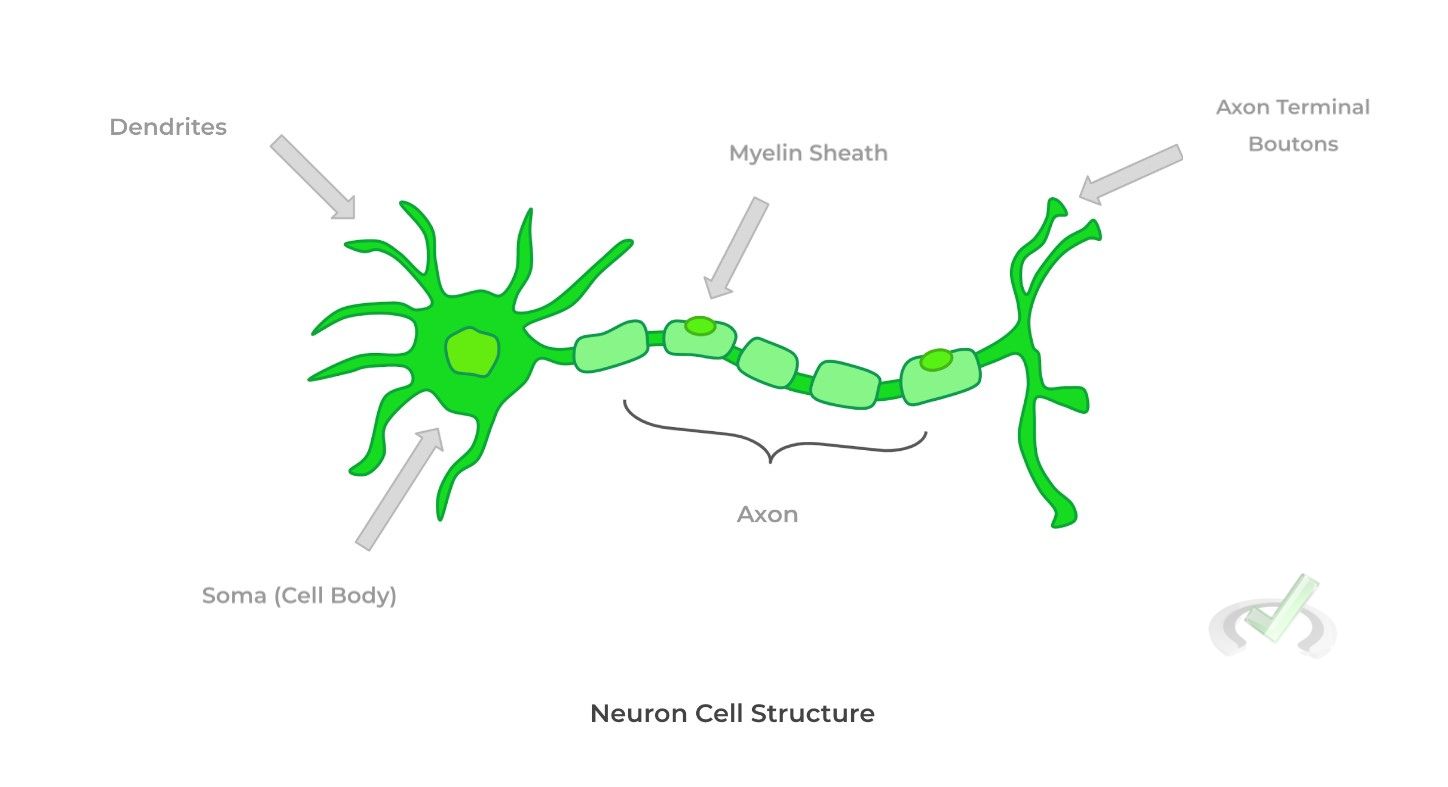
The light green coverings on the axon are called the myelin sheaths which are produced by oligodendrocytes and Schwann cells in the CNS and PNS, respectivelyThey work to insulate the action potential propagated down the axon.
An important structure involving neuron communication is the synapse, which is composed of the presynaptic neuron (i.e. the axon terminal boutons) and the postsynaptic neuron (i.e. dendrites).
When the action potential reaches the axon terminal bouton, it triggers the release of neurotransmitters, the chemical messengers of the nervous system, which diffuse across the synaptic cleft to bind to receptors on the postsynaptic dendrite.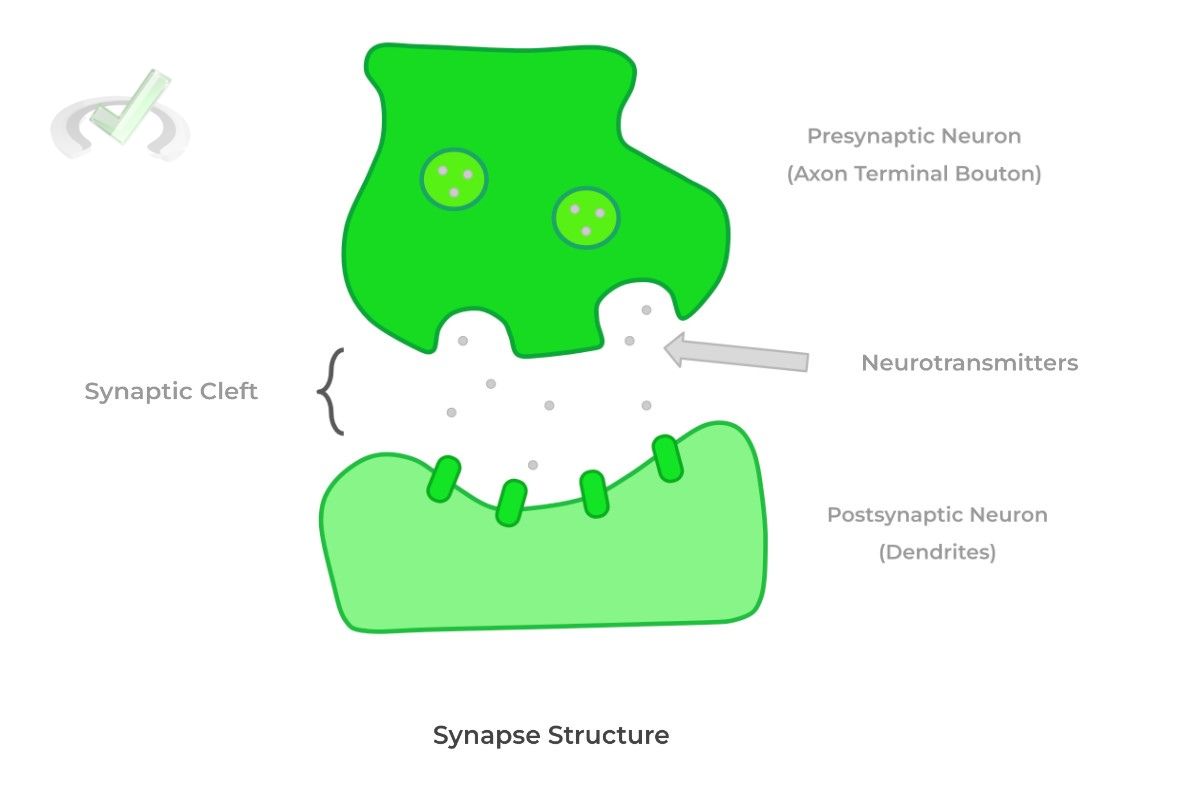
In addition to neurons, the nervous system also has many other support cells! Glial cells are the nervous system’s resident macrophages and astrocytes aid in clearing cellular debris in between neurons.
(Coming Soon!) Full Study Notes : Cells of the Nervous System
For more in-depth content review on the cells of the nervous system, their structure, and functions, check out these detailed lesson notes created by top MCAT scorers.
3. Action Potential Propagation
The action potential is crucial in neuronal communication because, as stated before, it results in the release of neurotransmitters at the axon terminal boutons.
When released, the neurotransmitters can result in the activation of another action potential in the postsynaptic neuron, depending on the neurotransmitter and receptor.
Interestingly enough, action potentials are driven by changes in the electrochemical gradient along the axon: this is just a fancy way of saying that the axon experiences changes in both charge and ion content over the course of the action potential!
There are 4 main phases that occur during the action potential, as listed below, with each process resulting in a distinct change in the charge and ion content.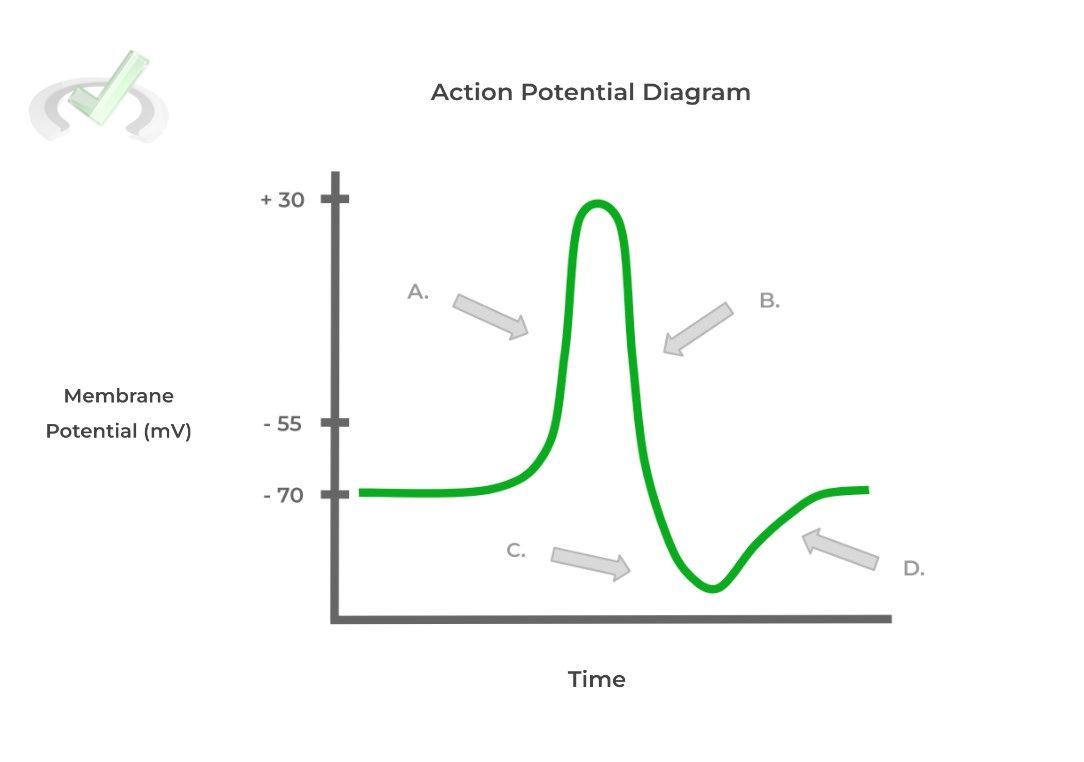
A. Depolarization: Na+ Influx Into Cell ⇒ More Positive Intracellular Charge
B. Repolarization: K+ Efflux Out of Cell ⇒ More Negative Intracellular Charge
C. Hyperpolarization: Excess K+ Efflux Out of Cell ⇒ Highly Negative Intracellular Charge
D. Restoration: Reestablishment of Sodium/Potassium Gradient via Na+/K+ ATPase ⇒ Resting Membrane Potential (-70mV)
These phases occur throughout the axon, where an action potential in a preceding region triggers the set of action potential phases in a succeeding region. Think of it like a domino effect!
Just like a row of dominoes falling in succession by a push of a finger, an action potential also travels down along the axon until it reaches the axon terminal!
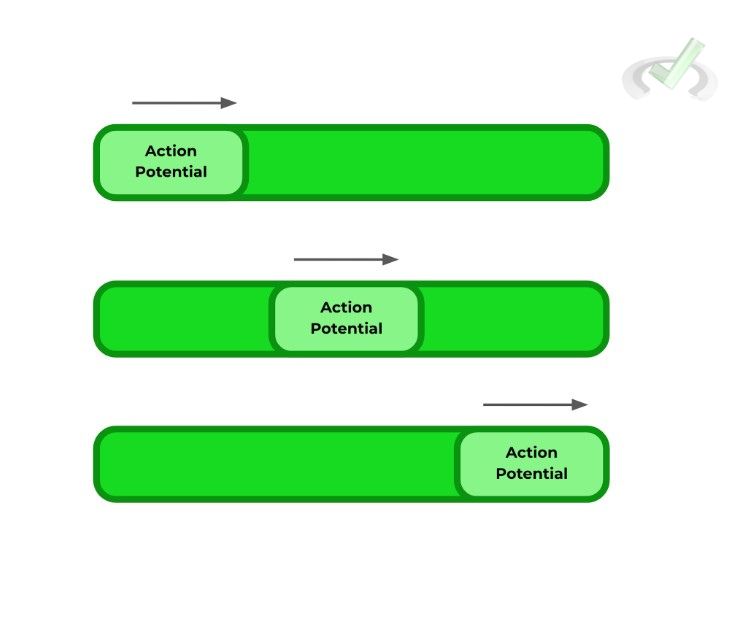
A deeper review on action potential propagation and all the different processes involved can be found in the full study notes link below!
(Coming Soon!) Full Study Notes : Action Potential Propagation
For more in-depth content review on action potential propagation and all the different processes involved, check out these detailed lesson notes created by top MCAT scorers.
Important Definitions and Key Terms
Below are some high yield definitions and key terms to refer to when reviewing the nervous system!
Term | Definition |
|---|---|
Central Nervous System | Division of the nervous system which consists of the brain and spinal cord |
Peripheral Nervous System | Division of nervous system which consists of the nerves outside the CNS |
Autonomic Nervous System | Division of peripheral nervous system involved in unconscious, involuntary function such as heart rate |
Sympathetic Nervous System | Branch of autonomic nervous system which enacts your “fight or flight” response during times of stress |
Parasympathetic Nervous System | Branch of autonomic nervous system which enacts your “rest and digest” response when stressful stimuli is not present |
Soma (Cell Body) |
Portion of the neuron which performs all basic cellular function |
Axon |
Neuronal structure which allows for the propagation of an action potential towards the terminal boutons |
Dendrites |
Extensions from the neuronal cell body which receive signals from other neurons |
Synapse |
Neuron cellular junction composed of a presynaptic neuron (axon terminal bouton) and postsynaptic neuron (dendrites) |
Neurotransmitters |
Main chemical messengers of the nervous system |
Action Potential |
Sequence of electrochemical changes that occur down the neuron’s axon to trigger the release of neurotransmitters |
Additional FAQs - Nervous Systems on the MCAT
A. What are Ganglia – MCAT?
B. What is the Vagus Nerve – MCAT?
C. Is Brain Anatomy on the MCAT – MCAT?
However, you’re most likely going to see brain anatomy tested on the Psych/Soc section as the Biology section will tend to focus on the nervous system overall such as neuron structure, the process of action potential propagation, etc.
D. What are the 6 Types of Nervous Systems – MCAT?
Additional Reading Links (Coming Soon!) – Nervous Systems on the MCAT
Additional Reading: MCAT Biology Topics:
- Cells on the MCAT
- Digestive Systems on the MCAT
- Embryogenesis and Development on the MCAT
- Endocrine Systems on the MCAT
- Excretory Systems on the MCAT
- Genetics and Evolutions on the MCAT
- Immune Systems on the MCAT
- Cardiovascular Systems on the MCAT
- Musculoskeletal Systems on the MCAT
- Reproduction on the MCAT
- Respiratory Systems on the MCAT


 To help you achieve your goal MCAT score, we take turns hosting these
To help you achieve your goal MCAT score, we take turns hosting these